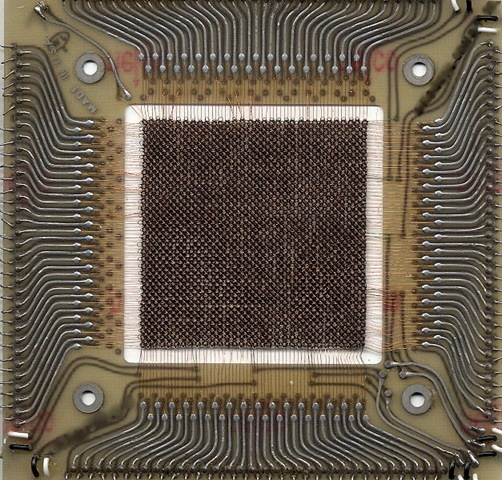How
core memory works
The
most common form of core memory, X/Y line
coincident-current – used for the main memory of a
computer, consists of a large number of small ferrite (ferromagnetic
ceramic) rings, cores, held together in a grid structure
(each grid called a plane), with wires woven through the
holes in the cores’ middle. In early systems there were four
wires, X, Y, Sense and Inhibit,
but later cores combined the latter two wires into
oneSense/Inhibit line. Each ring stores one bit (a 0 or
1). One bit in each plane could be accessed in one
cycle, so each machine word in an array of words was spread over
a stack of planes. Each plane would manipulate one
bit of a word in parallel, allowing the full word to be read or
written in one cycle.
Core
relies on the hysteresis of the magnetic material used to make the
rings. Wires that pass through the cores create magnetic fields. Only
a magnetic field greater than a certain intensity ("select")
can cause the core to change its magnetic polarity. To select a
memory location, one of the X and one of the Y lines are driven with
half the current ("half-select") required to cause this
change. Only the combined magnetic field generated where the X and Y
lines cross is sufficient to change the state; other cores will see
only half the needed field, or none at all. By driving the current
through the wires in a particular direction, the resulting induced
field forces the selected core’s magnetic flux to circulate in one
direction or the other (clockwise or counterclockwise). One direction
is a stored 1, while the other is a stored 0.
 Close-up
of a core plane similar to the one shown at top. The distance between
the rings is roughly 1 mm (0.04 in).
The green horizontal wires are X; the Y wires are dull brown and
vertical, toward the back. The sense wires are diagonal, colored
orange, and the inhibit wires are vertical twisted pairs.
Close-up
of a core plane similar to the one shown at top. The distance between
the rings is roughly 1 mm (0.04 in).
The green horizontal wires are X; the Y wires are dull brown and
vertical, toward the back. The sense wires are diagonal, colored
orange, and the inhibit wires are vertical twisted pairs.

 Close-up
of a core plane similar to the one shown at top. The distance between
the rings is roughly 1 mm (0.04 in).
The green horizontal wires are X; the Y wires are dull brown and
vertical, toward the back. The sense wires are diagonal, colored
orange, and the inhibit wires are vertical twisted pairs.
Close-up
of a core plane similar to the one shown at top. The distance between
the rings is roughly 1 mm (0.04 in).
The green horizontal wires are X; the Y wires are dull brown and
vertical, toward the back. The sense wires are diagonal, colored
orange, and the inhibit wires are vertical twisted pairs.